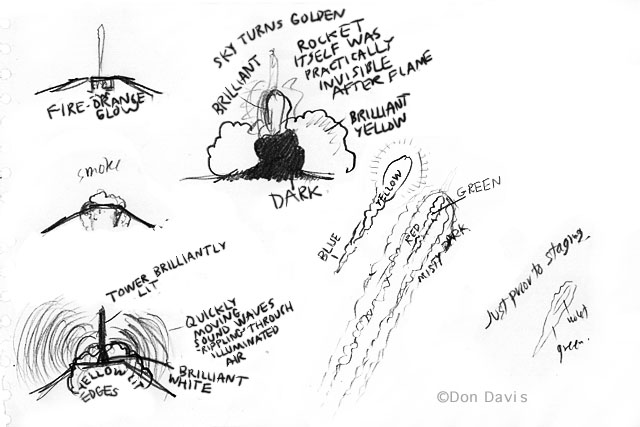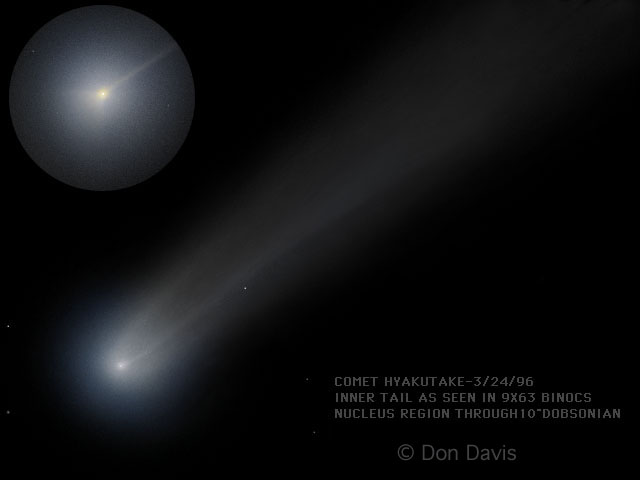
COMETS
Comet Hyakutake
March 23 1996
Naked eye: Even as we filled up our cars, the inner coma and maybe
just a hint of inner tail was visible, peering defiantly from
beyond the street lamps of Los Angeles. As we drove beyond the
realm of the lights, the tail gradually was unveiled along with
the stars.
At Mt. Pinos, the stars finally looked the way they
should, numerous and bright above the trees around us. Overhead
Comet Hyakutake now dominated the heavens! There it was, a fantastic
apparition spread across the familiar constellations, like a ghostly
searchlight beaming from some invisible titanic lighthouse! The
coma, easily a degree or more wide, is round and fuzzy, and bright
enough near the center to be seen from cities.
The tail reminded me a little of 'headlights' of airliners illuminating
the air before them on humid nights. Scanning the sky with the
more sensitive peripheral parts of the retina revealed the full
60+ degrees of the fainter stretches of the tail. Although I couldn't
commit to a firm color evaluation if pressed I would call the
naked eye impression a decidedly cool gray.
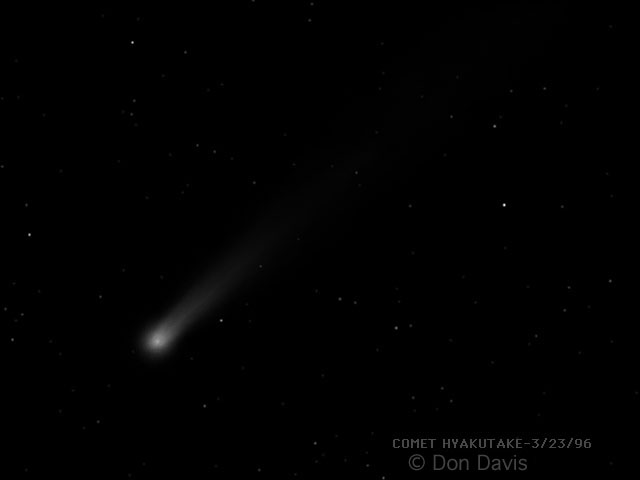
Through 9X63 binoculars: The coma seemed a faintly luminous blue color, a round and very smooth cloud extending noticeably beyond the width of the tail. The tail was in two elements, one short and diffuse,which seemed to begin as a bow shock like sharper boundary of brightness within the sun ward portion of the brighter inner coma, then streaming away from the sun like a continuation of the inner coma. The other tail feature was a linear streak, very thin near the nucleus, which widened noticeably as it merged with the overall tail. Fainter parallel streamers also fanned out adding to the very long and relatively narrow beam like tail. Looking back and forth through binoculars and then the eye provided the best visual impression.

Through a 10 inch telescope, low power eyepiece: The field of view was filled with luminous mist, becoming quite bright and showing a yellowish ivory color near the nucleus region. The outer, dimmer portions were a bluish color, with an ill defined turquoise gray extending across the transition region to the brightest nucleus region. A fine luminous line formed a very thin 'tail core', following closely the direction the invisible shadow of the nucleus. On the sun ward side a vaguely defined 'fan' shaped spray streamed from the nucleus,forming a volume like a 90 degree conical slice of a sphere.
Comet Hale-Bopp
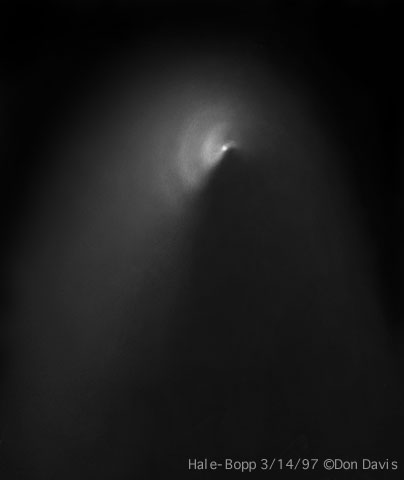
The nucleus was a wondrous sight to behold! The brightness of
the coma and nucleus region made it's examination rewarding from
anywhere the sky was clear. This is the view through my 10 inch:
A brilliant point of light was the source of a complex
spray of translucent misty layers. The overall impression of the
dust being heaved off to one side persisted from much earlier
observations, but superimposed on this massive northward spray
were a series of thin concentric arcs surrounding the nucleus
! These resembled a corkscrew pattern flowing from the nucleus,
of which only the near side of the 'loops' stood out. Sometimes
I thought they looked like hollow round 'shells' puffing out from
one side of the erupting body.
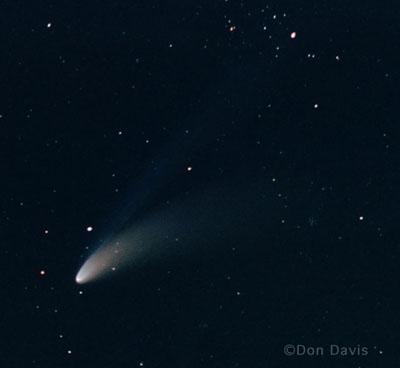
The night of April 9th, I saw Hale-Bopp in it's full glory for the last time, just me on a deserted road and the comet. I made sketches with the aid of binoculars and took photographs. Later I scanned the photo and in Photoshop added the details near the nucleus I had sketched but were overexposed on the original photo.
Meteors
November 18, 2001: The Leonid meteor shower was the best
I had ever seen, with more than one meteor per second visible
around the peak at roughly 3:30 AM Pacific time. Using my Nikon
Coolpix 990 digital camera I took time exposure images of the
sky hoping to capture some meteors. The camera was not really
designed for this kind of task, yet I did obtain some viewable
results despite the fiendish skill meteors displayed in occuring
outside the field of view!
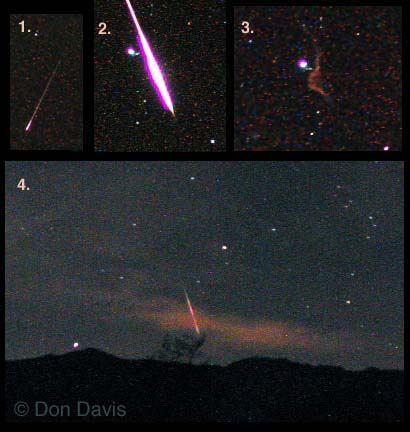 1. A
typically bright meteor, perhaps as bright as Sirius, brightest
of stars we see.
1. A
typically bright meteor, perhaps as bright as Sirius, brightest
of stars we see.
2. An exceptionally bright meteor, or fireball which just made it into the camera field of view, near the 'hind legs' of the constellation Canis Major.
3. The glowing trail from the same bright meteor is shown about a minute later, being distorted by high altitude winds. No color was visually seen.
4. a Leonid passes behind a cloud which is illuminated by light pollution from Los Angeles.
Below: The first light of dawn at the base of the zodiacal light.
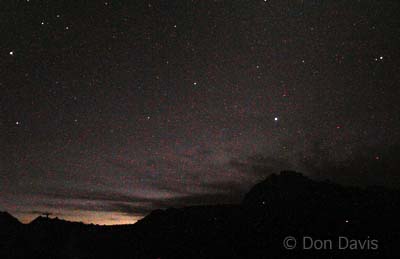
The less 'grainy' pictures above were made later in that very cold morning. Cooling the CCD imaging device lessons the noise when shooting a dark image over many seconds.
During the Leonid meteor shower of November 2000 I saw about 25 bright meteors in less than three hours of pre dawn observing. The most common type seen was the 'bright white streak' as drawn on the top drawing below. Less common were slower moving meteors with more diffuse 'heads'. Two such examples are shown below, one with an orange slightly hazy 'head' which I saw once. Another type I saw twice that night is fairly dim, and 'puffs' itself outwards into a diffuse bow shock like cloud as it fades.
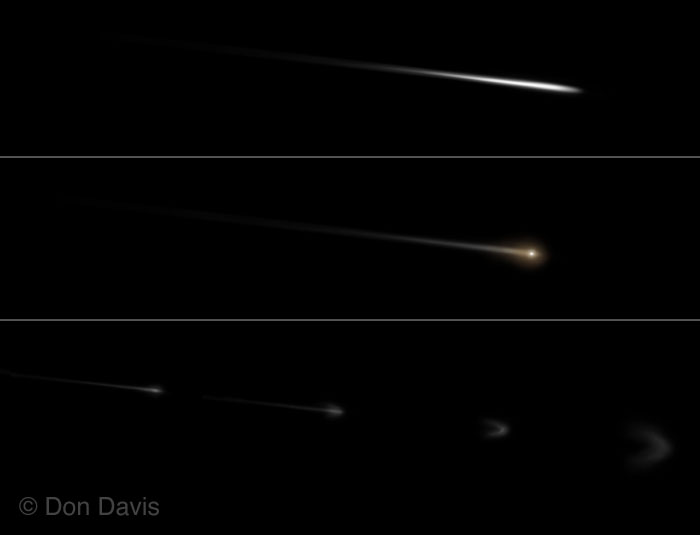
The Green Flash and related phenomena
Very few people have seen the Green Flash, yet it is not that rare an event if you are in a position to see the sun set at or near the distant horizon. The best place is from an elevated vantage point near the sea. The 'chromatic aberration' of the Earths atmosphere is only evident in clear skies near the horizon. If the Sun is reddened only slightly as it nears the horizon the odds are increased you will see it. The red and blue portions of the spectrum are slightly displaced from each other in varying amounts and in the case of the Suns disk the last bit of the upper rim to slip below the horizon can briefly turn a bright green, with a much fainter blue and violet trace rarely seen above that.
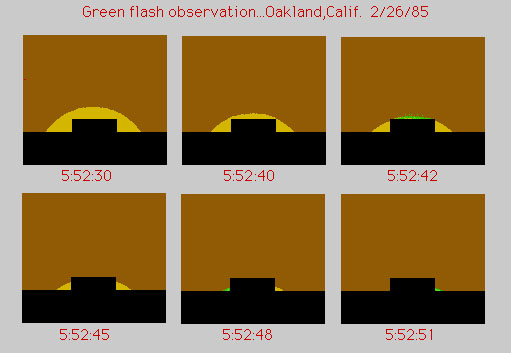
One does not always need to be in the parks and beaches to see the 'Green Flash'. This example was from an observation made in Oakland, California, as the Sun slipped behind a distant building. On this occasion I was able to see the green upper rim three times!
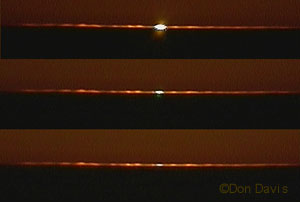
These frame grabs from my DV camcorder show a rather weak Green Flash seen from Windy Hill in the San Francisco Bay area, which overlooks the distant ocean horizon. Only the middle frame shows anything of the green color of the last bit of the Sun as it slipped under the horizon topped by a distant fog bank. A greater telephoto view and a darker exposure are needed to record this elusive chromatic display.
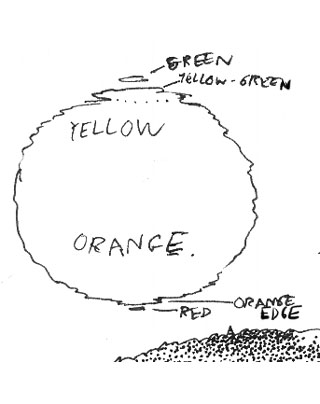
From Kitt Peak after observing Comet West I saw an amazing demonstration of the power of the atmosphere to play with the images of distant objects. As the Sun rose it passed through layer after layer of changes in the density of the atmosphere. These caused the light to refract a little so as to cause tiny tapering green bits to appear, grow, and merge with the brilliant disk. Trying to avoid burning out my eyes, I watched with the help of intervening cloud masses as the bottom of the Sun repeatedly pinched off flat bits of flame, which deepened to a orange and even at times crimson color as they faded.
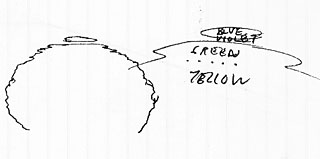
On the same occasion as above I saw a bit of the blue-violet part of the spectrum expressed as a 'indigo flash' atop a green one. I have never seen such a thing since.
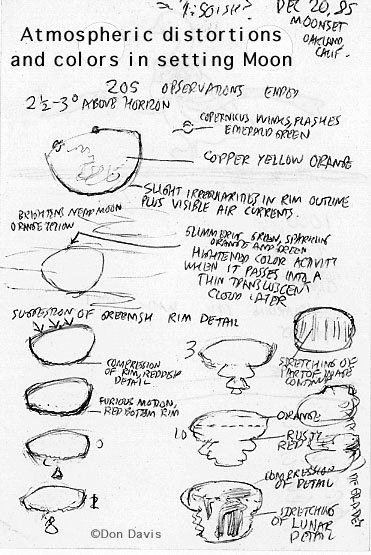
Not only the Sun, but occasionally the Moon and brighter planets can show off the chromatic displacement of images near the horizon when the conditions are right. These sketches record the scintillating green appearance of the tiny detached rim of bright Copernicus crater, as well as the momentary resemblance between the distorted Moon and a distant atomic mushroom cloud! At times there were even stretching of lunar features reminding one of a 'fun house' mirror! The moon then dimmed as it set into a murky atmosphere.
Here is an image taken with a digital camera of the star Sirius, which was deliberately 'scanned' across the field of view to allow the chromatic irregularities in it's light due to unsteady 'seeing' to show. These colors are more evident to the eye, in the case of stars which are nearly white the variety and purity of these sparkling bursts of color can be quite striking in times of marked atmospheric turbulence.
![]()
Other sights
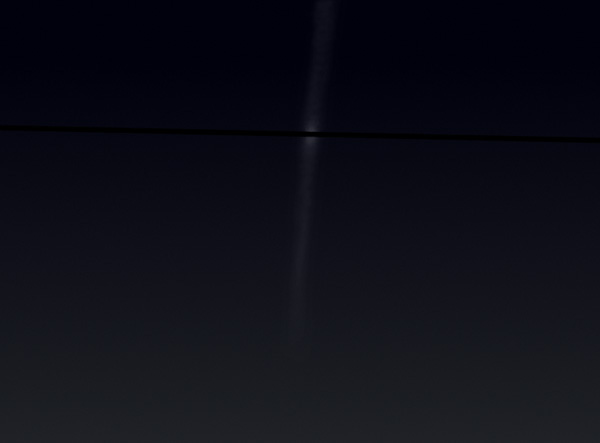 Jupiter
can be fairly bright, in January 2001 I saw a jet contrail pass
over Jupiter, and I moved to place the brilliant dot of light
behind an overhead telephone wire. Interestingly, a noticable
amount of forward scattered light was seen in the thin high cloud
near the hidden planet. s
Jupiter
can be fairly bright, in January 2001 I saw a jet contrail pass
over Jupiter, and I moved to place the brilliant dot of light
behind an overhead telephone wire. Interestingly, a noticable
amount of forward scattered light was seen in the thin high cloud
near the hidden planet. s
In the 1970's I visited Meteor Crater in Arizona, climbed the sides, and walked across the interior. About half way down I tried to sketch the surroundings, carefully trying to show the perspective of being in an impact crater.
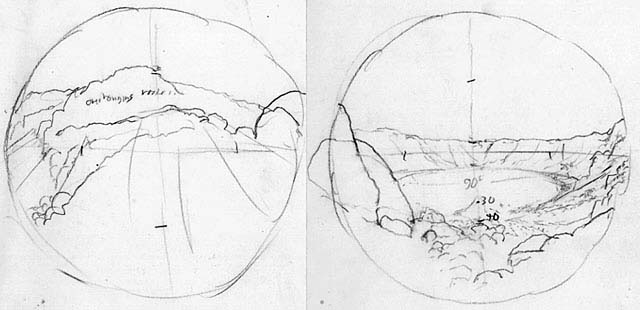
I observed the only night launch of a Saturn V and watched a good deal of it through binoculars. I made these notes while still aboard the SS 'Statendam'.
